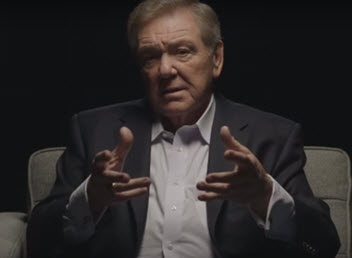Jim Camp – Lost Negotiator Vault Tape
$597.00 Original price was: $597.00.$68.40Current price is: $68.40.
There’s a reason why the FBI changed their negotiation protocols after learning Mr. Camp’s methods, File Size: 231.6 MB
Jim Camp – Lost Negotiator Vault Tape
|
|
| I’m Michael Senoff and I spent close to a year securing and negotiating for the rights to the late, great Jim Camp’s original trainings and teachings — which were recently re-discovered in the Camp Estate vaults on audio cassettes. These recordings from the mid 1980s are the “for real” secret and reveal Jim Camp at the top of his game. They are unlike anything I had heard before, including when I personally grilled Jim Camp on over 150 of his best methods in a Q&A program a decade ago.There’s a reason why the FBI changed their negotiation protocols after learning Mr. Camp’s methods, and why his material has been required reading by the most prestigious and expensive business schools in the country. And these “lost” tapes — remastered on digital MP3 — contain his entire 18-part methodology he taught live to his elite private students.
The only other way to get this material is to spend months tracking down and even outright nagging the Camp Estate to sell them to you. But even then, you’ll have to pay $597 — while they have agreed to give me the exclusive rights to sell them at $97 for a very limited time. That’s why the deadline to get them is Monday, May 27th at midnight PST. |
| HERE’S WHAT YOU GET |
| 1. The System For Landing Clients That Starts With “No”:
– Part One contains a 14:03 minute audio and an accompanying 5-page transcript. For the full description of each interviewclick here. 2. Exploding The “Yes” Myth – Part Two contains a 22:15 minute audio and an accompanying 8-page transcript. For the full description of each interviewclick here. 3. Why “Maybe” Is Never An Option: The Rules Of A Negotiation – Part Three contains a 14:40 minute audio and an accompanying 7-page transcript. For the full description of each interview click here. 4. How To Take Control Of Your Negotiations By Taking Control Of Your Behavior – Part Four contains a 21:43 minute audio and an accompanying 8-page transcript. For the full description of each interview click here. 5. The Little-Known Magic Of Showing You’re “Not Okay” In A Negotiation – Part Five contains a 10:50 minute audio and an accompanying 5-page transcript. For the full description of each interview click here. 6. The One Best Way To Control Emotions In A Negotiation While Creating Vision In Your Adversary – Part Six contains a 20:30 minute audio and an accompanying 4-page transcript. For the full description of each interview click here. 7. The Essential Scripts And When To Use Them – Part Seven contains a 18:21 minute audio and an accompanying 7-page transcript. For the full description of each interview click here. 8. The Secret To Being A Winner – Part Eight contains a 24:36 minute audio and an accompanying 4-page transcript. For the full description of each interview click here. 9. The Greatest Weakness In A Negotiation And How To Stop It – Part Nine contains a 07:07 minute audio and an accompanying 4-page transcript. For the full description of each interview click here. 10. How To Use Questions To Turn On The Discovery Channel – Part Ten contains a 12:52 minute audio and an accompanying 4-page transcript. For the full description of each interview click here. 11. How To Gain Control Of Negotiations By Being Quiet And Nurturing – Part Eleven contains a 9:26 minute audio and an accompanying 6-page transcript. For the full description of each interview click here. 12. The Weaknesses Of A Win-Win Negotiation Revealed In Real Time – Part Twelve contains a 14:42 minute audio and an accompanying 5-page transcript. For the full description of each interview click here. 13. The Essential Checklist For Every Negotiation – Part Thirteen contains a 22:48 minute audio and an accompanying 5-page transcript. For the full description of each interview click here. 14. Why You Absolutely Need A Mission And Purpose (And How To Create One) – Part Fourteen contains a 23:13 minute audio and an accompanying 7-page transcript. For the full description of each interview click here. 15. Taking Control Of Every Negotiation By Creating A Framework – Part Fifteen contains a 33:39 minute audio and an accompanying 7-page transcript. For the full description of each interview click here. 16. Be Ready For Your Next Negotiation By Logging Your Last One – Part Sixteen contains a 27:59 minute audio and an accompanying 8-page transcript. For the full description of each interview click here. 17. How To Turn Any Negotiation Around – Part Seventeen contains a 53:57 minute audio and an accompanying 11-page transcript. For the full description of each interview click here. 18. Eliminating The Wildcards In The Decision-Making Process – Part Eighteen contains a 28:48 minute audio and an accompanying 9-page transcript. For the full description of each interview click here. 19. Bonus Interview – Inside Jim Camp’s Mind From One of The Men Who Knew His Best. And interview with Copywriter David Garfinkle – Part Nineteen contains a 52:48 minute audio and an accompanying 43-page transcript. For the full description of each interview click here. 20. Bonus Interview – An Inside Look At What The Camp Group is Doing Now That Jim Camp Is No Longer With Us. And Interview with Todd Camp and Lead Negotiator David Desantis. – Part twenty contains a 32:48 minute audio and an accompanying 23-page transcript. For the full description of each interview click here. 21. Bonus Video – How elBenbo Has Used Jim Camp’s Negotiation Methods For The Last 11 Years To Blow Right Past His Most Successful Competitors – Part Twenty-one contains a 86 minute video For the full description of each interview click here. |
|
| If you’ve ever lowered your price, lost a prospect or compromised on anything in your personal or professional life, these Jim Camp Estate “Lost” Negotiator Vault Tapes may change everything for you.
Hear Jim Camp live and teaching a group of professional his System of Negotiation. Jim teaches the fundamentals of negotiation mindset, behaviors, and structure over 18 sessions totaling 6 hours and 30 minutes. The lessons are delivered in high-quality audio mp3 and include the transcripts of all the sessions. Additional downloads describe how to make a Mission and Purpose statement, pre-negotiation checklists and the post-negotiation log. Download, listen to or read the transcripts to all 18 parts your Jim Camp Estate “Lost” Negotiator Vault Tapes Then study and use his techniques and you’ll gain an understanding about the one of the most powerful life secrets known to man. How to negotiate winning agreements. |
Get immediately download Jim Camp – Lost Negotiator Vault Tape
The second you place your order, PayPal will re-direct you to a page with a blue button that when clicked will take you to your Jim Camp Lost Tapes Download Page.
Whether you order from your phone or desktop computer, you should see the image below with the blue or white “Return To Merchant” button.
You want to click on that button to access your downloads.
If it does not work, as a backup, I will also send you the links by e-mail to the PayPal e-mail address you used when you ordered.
Either way, only seconds from the time you order, you will have a direct link to your Jim Camp Estate “Lost” Negotiator Vault Tapes Downloads.
| If you have any questions text or call 858-692-9461. Sincerely,Michael Senoff |
| Your Jim Camp Estate “Lost” Negotiator Vault Tapes Detailed Descriptions Below
You’ll be able to immediately download your Jim Camp Estate “Lost” Negotiator Vault Tapes Instantly After Payment Is Received Which Includes . . . |
| 1) The System For Landing Clients That Starts With “No”:
Jim Camp passed away a few years ago, but he will forever be remembered for his Negotiator System that teaches salespeople worldwide that landing clients can start with the word “no.” Sales meetings and calls are just negotiations, and in any negotiation, you’re going to hear the word “no” a lot. Jim uses it as a jumping-off point. But you have to have a system in place before you do it. When Jim was a young fighter pilot, he learned there were steps you could take in any given situation that would save your life, and if you practiced them enough in a safe environment, you would default to those steps when the going got rough. It’s the same with sales. By developing habits within a tried-and-true system, you will have all the tools you need for successful negotiations. And in this audio, you’ll get a look at what those are and how to use them along with . . . • How the comment “Sit down, stupid” from a major during Jim’s fighter pilot training changed Jim’s whole perspective of systems and helped him shape the principles of his negotiator one • The “insider” secrets of using failure as a catalyst to success: exactly why it’s so important to allow yourself to fail in a no-risk situation, and how to do that • The fastest known way to kick yourself into developing more effective habits in sales and in life Jim says, when it comes to negotiations, the real problem we have begins with control. Often times, our need to be in control makes our behavior out of control, essentially killing a sale before it’s even begun. That’s why it’s so important to have that system in place and your behavior practiced. And in part one, you’ll hear all about it. – Part One contains a 14:03 minute audio and an accompanying 5-page transcript. Click To Order 2) Exploding The “Yes” Myth We’ve all been trained to love the word “yes.” We want to say it, hear it, and expect it as the only acceptable answer in a negotiation. That’s why in part two, you’ll listen in as Jim conducts a workshop with businesspeople that challenges their beliefs, while exploding this “must hear yes” myth. According to Jim, “no” is just a decision. In fact, it’s the safest decision your adversary can make, so expect to hear it a lot. But, like any other decision, it’s one that can be changed. So it can actually be a good jumping-off point. And in part two, you’ll hear how to do that including… • The single most important word in a negotiation – respect – what that means and what it doesn’t • Examples of how your adversary will always mirror your behavior, and how to use that to get them to make a decision quicker (with no being a completely acceptable decision) • The simple little lesson about negotiations you can take from the child who gets “no” from daddy, and then goes to mom • The real reason it never works out when you try to take away someone else’s right to say no: Examples from history of people who have stolen that right or have had it stolen from them, and how that worked out Because we’ve been trained to view “no” as a negative, when we hear it, it gets our emotions going and throws us off our game. But Jim says it’s not a rejection. It’s just a decision. Period. And in this audio, you’ll listen in as Jim uses the tools of his system to teach his system, while showing you the power of “no,” and where to take it from there. – Part Two contains a 22:15 minute audio and an accompanying 8-page transcript. 3) Why “Maybe” Is Never An Option: The Rules Of A Negotiation Jim says the most dangerous answer in any negotiation is maybe. When you allow your adversary to say “maybe,” you’re saving them from making a decision. And you’re not allowing them to see the real pain. That’s why having a system in place is so critical. We have been trained by habit to allow “maybes” in life when we shouldn’t. Jim says negotiations are one hundred percent emotional until a decision is made. “No” is a valid decision, but “maybe” is not. And in part three, you’ll hear all about that, and the other principles and rules that make up the Negotiator System including . . . • The four levels of decision making and why Jim says it’s so important to remember you can’t have action without vision, what that means and how to frame your negotiations around it • The simplest lesson to take from Japanese culture about effective negotiations and decisions • The three books Jim had in his possession at the time of this workshop, and why you may want to pick them up too • Examples from Vietnam of how training comes into play, keeping you calm in even the craziest of circumstances. The good thing about having a system in place for negotiating is that when the going gets tough, you will calmly revert to the steps you’ve been trained for. And in this audio, you’ll hear all about them, including the importance of never letting maybe be your answer, or your adversary’s. Click To Order 4) How To Take Control Of Your Negotiations By Taking Control Of Your Behavior You may not realize it, but your behavior in a negotiation directly affects your adversary’s behavior. That’s why, even before the negotiation begins, you have to train yourself, especially when it comes to knowing the difference between need-mode and want-mode. Because need-mode usually kills a negotiation. Saying things to yourself like, “I need to make this sale,” “I need to call Jerry,” “I need to make three appointments,” causes your adrenalin to go up, your voice to rise into panic mode, and desperation to set in. And in part four, you’ll hear why this is so dangerous and how to keep yourself from doing it. You’ll also hear . . . • The shocking way we throw ourselves into need-mode even when the adversary says “yes” to us, along with the many other ways we show need in a negotiation and the simple strategies for taking back control • A little known fact: There are only two kinds of activities in the world (pay-side activities and non-pay-side), the difference between the two, and how to use that concept to increase sales • Exactly why Jim says you don’t win with action or reaction. You win with re-reaction: Here’s what that means and how to use it in a negotiation • The most dangerous negotiation there is (the one you don’t know you’re in), how that can happen and examples of how to make sure it doesn’t • The scary — and often overlooked — side of the “trick close” in sales (when you trick your adversary into signing on), and why Jim says just don’t do it • The crazy place Jim says is his favorite place to do negotiations, and why. As you go through the training in Jim’s Negotiator System, you’ll develop better habits like being more present and aware in negotiations. You’ll realize when you go into need-mode and you’ll be able to turn it around fast. Want-mode is clear-thinking mode. And in part four, you’ll hear how to keep yourself there. – Part Four contains a 21:43 minute audio and an accompanying 8-page transcript. Click To Order 5) The Little-Known Magic Of Showing You’re “Not Okay” In A Negotiation When we see someone being “not okay,” it makes us feel a little more okay about ourselves. It’s why we love soap operas. It’s why we try our best to help people less fortunate than we are. It’s also why the first thing Jim does when he comes into a room is loosen his tie, unbutton his collar, and roll up his sleeves. It’s all part of the strategy Jim calls being not-okay on purpose. Think about it. How many people like to be around a snooty know-it-all who tries to be perfect? Being not-okay breaks down barriers. It makes you seem like a regular guy, and makes your adversary feel more at ease. And in part five, you’ll hear all about the little ways you can achieve being not okay and how to use it in your next negotiation. You’ll also hear . . . • The secret of how President Reagan used the not-okay concept in press conferences and meetings and why Jim calls him a master communicator • A quick look at being not okay from your adversary’s perspective: How will it make them feel to be around you? How can you expect them to react? How would they react around a perfect person? • The little lesson about not-okayness you can learn from the TV series Colombo • Five simple ways you can show not-okayness at your next meeting Being not-okay doesn’t mean you’re being unprofessional or acting like a fool. It simply means you’re using strategies to make your adversary feel more comfortable by making you seem more human and likeable. And in this audio, you’ll hear all about it. – Part Five contains a 10:50 minute audio and an accompanying 5-page transcript. Click To Order 6) The One Best Way To Control Emotions In A Negotiation While Creating Vision In Your Adversary Jim calls it the blank slate. It’s when you don’t think about anything else in a negotiation except listening. No talking. Taking notes is good. Asking questions to clarify is okay. But you’re not assuming anything about your adversary. You’re not wondering if you’ll make the sale, or trying to think of the next thing to say. The only thing you’re doing is being in your adversary’s world. And in part six, you’ll listen in on another workshop with Jim where he helps businesspeople, like you, develop the kinds of tools that will help them see their You’ll also hear . . • The single biggest reason we’re all trained to try to think of what to say next when we should be listening, and how to un-train yourself • The only time you can get blindsided when you’re blank slating and how to prevent it • An example about blank slating you can take from Joe Montana and a two-minute drill • Three things that can kill your blank slate, even if you’re good at it • Exactly what to do if you’re feeling tired or overwhelmed during a meeting and you’re not able to concentrate properly Our ability to see the other person’s vision is critical to our success as a professional negotiator. Expectation, fear and need all destroy our ability to open our mind to our adversary, which is why blank slating is such an important tool. And in part six, you’ll hear all about it. – Part Six contains a 20:30 minute audio and an accompanying 4-page transcripts. Click To Order |
| 7) The Essential Scripts And When To Use Them
Jim says there are two essential scripts we use as professional negotiators: the nurturing- parent script and the adult-with-information one. Although child scripts and critical parent scripts exist (and are good to recognize because your adversary may use them), you shouldn’t use them in your negotiations. And the good news is once you’ve begun recognizing scripts, if an adversary says something like, “Don’t call me again. I’ll call you,” you’ll be able to take a step back, recognize that as a “critical parent” script that is basically telling you, “Children are seen but not heard,” and you won’t fall into the trap of responding with a child script. If you instead respond with a nurturing parent or an adult-with-information one, you’ll be able to turn the negotiation back around and gain control again. And in part seven, you’ll hear what this all means and how to do it. You’ll also hear . . . • An in-depth look at each script: when and how we develop unhelpful scripts and how to change them • How to deal with angry administrative assistants who seem to have critical parent down • The real reason using the wrong script/tape can cause you to lose a deal, and how to make sure that doesn’t happen to you • The “can’t miss” way to develop better scripts for yourself simply by listening to the natural way people respond in negotiations • A word-for-word look at how to use strip-lines with your scripts to move a negotiation along, even when it seems to be going nowhere • The key scripts to use when your adversary seems very excited about your product or service so you can bring them back to center, and why you definitely want to do that. Jim says our ability to use nurturing parent and adult with information is critical to our success as professional negotiators. If you recognize the scripts, you can bring even the most out of control negotiations back to a realistic state. And in this audio, you’ll hear all about them. – Part Seven contains a 18:21 minute audio and an accompanying 7-page transcript. Click To Order 8) The Secret To Being A Winner According to Jim, there are three types of people in the world: winners, losers, and the average guys. It’s probably no surprise that Jim says you should try to be a winner. But it might be surprising to know just how important that is in a negotiation. In fact, Jim says it’s the most important part, probably because winners expect to win. They take responsibility for their actions and behavior and they do everything to prepare themselves for a competition. But if they should lose, they look at it as a learning experience. Losers blame everything on everyone else, and the average person just tries to get by on the least amount of effort. That’s why in part eight, you’ll hear all about the power that self-esteem plays in a negotiation, and how to make sure you go into yours with the best possible outlook. You’ll also hear… • The little-known characteristics of a winner, and what Vince Lombardi really said about winning • The demystifying truth about winning that you can learn from the kid playing Little League who thinks he’s the best, and doesn’t need to learn anything new • The real reason why it’s so important to pay it forward in life • A weird (but effective) way to view self image (the “I” and the “Our”), how predators attack our I (our individual self), and how to become immune to it • Key strategies you can take from Neil Armstrong, John Glenn, and every fighter pilot who’s ever lost his or her perfect vision and had to make a role switch in life • The secret of starting every competition the way Jack Nicklaus did in his day (He didn’t just show up at the golf course and expect to play well. He prepared months in advance) Jim says we learn our roles growing up. Were we a smart baby or a slow one? Were we a good student or one who struggled at every turn? And we engrained those roles into our self-image today. The good news is, something learned can be relearned. And in this audio, you’ll hear how you can start being a winner today and what a difference that can make in not only your negotiations in life, but in life itself. – Part Eight contains a 24:36 minute audio and an accompanying 4-page transcript. Click To Order 9) The Greatest Weakness In A Negotiation And How To Stop It Jim says, when it comes to negotiations, making assumptions is one of the greatest weaknesses you can have. Problem is, it’s also one of the hardest to quit because we’ve all been trained our entire lives to make assumptions, about everything from what the person we are talking to is going to say next to life itself. That’s why in part nine, you’ll hear the real dangers in making assumptions, how they can mess up a negotiation, and how to stop making them. You’ll also hear… • The crazy way school teaches kids to make assumptions, and what usually happens when they get things wrong • The one way to eliminate assumptions that actually works • A little-known fact: we use assumptions to fight for our “okay-ness.” Here’s why that almost never works out for us • Examples of how assumptions have shaped the way we view history (Do you really know history or are you assuming things?) The habit of making assumptions can definitely hurt us in a negotiation. But the good news is, we can break the habit. It just takes practice and in this audio, you’ll hear how to do it. – Part Nine contains a 07:07 minute audio and an accompanying 4-page transcript. 10) How To Use Questions To Turn On The Discovery Channel Asking questions is one of the best ways to draw out your adversary’s pain and help them picture their world. But you can’t just ask any old question. In fact, Jim says there are two different kinds of questions: verb-led and interrogative questions. You’ll use both, but interrogative questions are the ones you’ll want to use the most. They start with who, what, where, when, why, how and sometimes which. When used correctly, Jim says they can turn the “discovery channel” on in your negotiation to help you find out valuable information, while keeping the conversation focused right where you want it to be – in your adversary’s world. And in part ten, you’ll hear exactly how to do that. You’ll also hear: • The little-known dangers of using verb-led question, and the one and only time it is safe to do that • The scary reason “Maybe” is never an acceptable answer (it is filled with emotion and has no vision) and exactly what to do if you hear it in a negotiation so you immediately refer back to their pain instead • Real-life examples of safe verb-led questions and interrogative ones in a negotiation • A simple, little trick that will help you know for sure whether or not you’re using questions correctly • A quick look at the huge differences between seemingly similar phrases like “What is the greatest challenge you face in this business?” and “What is the greatest challenge you face?” One is focused and will lead to discovery, the other goes nowhere. Here’s how to make sure you ask the kind of focused questions that will advance a negotiation The art of negotiation is just the ability to allow your adversary to accept your position as their own. The use of questions is a great way to do that. And in this audio, you’ll hear how. – Part Ten contains a 12:52 minute audio and an accompanying 4-page transcript. Click To Order 11) How To Gain Control Of Negotiations By Being Quiet And Nurturing The main goal of any negotiation is to keep your adversary talking. When they talk, they’re in their world. They can see their picture and expand on it. And this allows you to gather research, gain valuable information, and maintain control of the negotiation. Jim says the trick to keeping your adversary talking is by learning to be nurturing. This includes asking the right kinds of questions (interrogative questions are best, but safe verb-led ones work too) and by making sure our behaviors and mannerisms are nurturing too. And in part eleven, you’ll hear how to do that. You’ll also hear . . . • Examples of the three-plus technique in action (being able to answer the same question around the same topic three different ways), and how to do that • The first rule in a negotiation: never answer an unasked question. What that means and what to do instead • The simple little trick of using connecting statements to move the negotiation along, so you can keep everything flowing just the way you want it • The behavioral strategies that show nurturing (leaning back or leaning forward, going behind the desk or staying out in front). They may seem unnecessary, but these simple tricks help you gain control Our job as professional negotiators is to help the adversary feel okay enough that they keep talking so we can gather valuable information and maintain control of the negotiation. And in this audio, you’ll hear exactly how to do that. – Part Eleven contains a 9:26 minute audio and an accompanying 5-page transcript. Click To Order 12) The Weaknesses Of A Win-Win Negotiation Revealed In Real Time During one of Jim’s workshops, a spontaneous negotiation broke out that happened to be a good example of the weaknesses of the conventional win-win, give-and-take philosophy in negotiation while also showing you the principles of the system in action. While you listen to the audio, try to note how the behavioral tools and powerful concepts of the Negotiator System are applied to this situation. Notice the interrogative and verb-led questions and how Jim uses them to steer the conversation. It’s a real-life look at how to guide an adversary along, and in this audio, you’ll get an insider’s look at Jim doing it. You’ll also hear . . . • The masterful way the experts use the concepts of strip-lines, interrogative questions, verb-led questions, three-plus and reverse in action • Why the jury is no longer out about win-win, give-and-take, and compromises in a negotiation and what to look for instead • A quick look at some famous negotiations in history (like WW2 and the Waco, Texas standoff). Did they use compromises? If so, how did it work out for them? • A real-life example of staying in control of a negotiation by keeping your adversary talking In this audio, Jim shows you the principles of a negotiation in action, and why it’s so important to practice them in a safe setting so you’re always prepared. Jim says, “The worst negotiation to be in is the one you don’t know you’re in.” And in this audio, you’ll hear what it looks like to always be prepared. – Part Twelve contains a 14:42 minute audio and an accompanying 5-page transcript. Click To Order 13) The Essential Checklist For Every Negotiation Most people don’t think about what they want from a negotiation before they go into one. They never develop a mission and purpose. They don’t do research or prepare questions. They just go in thinking they’re going to wing it and be fine. Or, if they do any research, they load up on features and benefits so they can unload it all on their adversary as soon as possible. And that rarely works out for them. Jim says the only thing we’re trying to do in a negotiation is stay in control. And in part thirteen, you’ll hear how checklists and logs can help you do that. From who gets the coffee to what research to do on your adversary’s business, knowing everything you can about a negotiation before you go into one reduces stress and prepares you for success. And in this audio, you’ll hear exactly what goes into your checklist and where to take it from there. You’ll also hear . . . • An in-depth look at Jim’s checklist, and how to prepare one for yourself • The vital importance of ironing out the details of team behavior. Who’s going to talk and ask questions? Who will bring the materials? Jim says don’t wait to figure it out • The one and only goal to have when it comes to assumptions (get them out and eliminate them). Here’s how to do that • The five loaded questions you need to create for every negotiation that will keep your adversary talking the entire time, keep them in their world, and give you control • Examples of the problems we need to overcome that could harm us if we carry them into a negotiation – from fear of failure to worrying about poor products or services Jim says, even if you do nothing else, if you write down what you really want from a negotiation, your success rate will double. That’s why it’s part of the checklist. And in part thirteen, you’ll hear all about that and the other things in the checklist, along with how to use them in your next negotiation. – Part Thirteen contains a 22:48 minute audio and an accompanying 7-page transcript. Click To Order 14) Why You Absolutely Need A Mission And Purpose (And How To Create One) The most powerful thing you can hold in your hand when you enter into any negotiation is your mission and purpose statement. It’s an understanding of what you do, who you are, and what you bring to the table. And once you develop one, you’ll discover that your decision-making and goal setting will become easier because mission and purpose statements are the foundation of your system. Jim says the trick to a successful mission and purpose statement is to make sure it benefits your adversary and their world. And in part fourteen, you’ll get a step-by-step guide on exactly how to create one, along with what to do with it from there. You’ll also hear… • The four keys to a successful mission and purpose statement. What it is and what it’s definitely not • Exactly what Jim means when he says you are either working within your mission and purpose or you’re working in support of someone else’s, and an easy way to know when it’s time to branch out on your own • A simple truth: the accumulation of money and power can never be in your mission and purpose statement. Here’s what should go in there instead • A scary look at history and the leaders who didn’t quite get their mission and purpose statements right, and what happened next • How to develop a mission and purpose statement for all areas of your life, and how they can support each other to keep you focused and on track • The “no-sweat, no-brainer” way to do a brainstorming session that will help you create the perfect mission and purpose statement, and why it should always start with listing your features and benefits. Because your mission and purpose statement is such an integral part of decision-making and goal setting, once you have it in place the most critical parts of your system will come together. But creating one is easier than it sounds. And in this audio, you’ll hear exactly how to do it. – Part Fourteen contains a 23:13 minute audio and an accompanying 7-page transcript. Click To Order 15) Taking Control Of Every Negotiation By Creating A Framework The person who comes to the table prepared to deal with problems is always seen as effective. They don’t dance around issues. They look you straight in the eye and tell you what could go wrong, and even if they don’t have a solution, they come across as an effective decision maker. And everyone wants to work with effective decision makers. It’s the same way with negotiations, and it’s why Jim says you should always put problems first in the agenda of every negotiation. If you don’t know what an agenda is in a negotiation or how to make one, don’t worry. This audio will walk you through everything. You’ll also hear… • The five key points to an agenda: what has to be in there, what is optional, and the things you’ll definitely want to leave out • Why Jim always mentioned price right up front in his agendas as a potential problem (his services were expensive) and the scary outcome that can happen if you forget to do that • A simple fact: Never make assumptions during a negotiation. Here’s the one exception to that rule, and when to make it • The one thing Jim says will make you rich if you have it in place in your agenda (knowing what you want), why that’s so hard to figure out, and how to do it • Ten different examples of the baggage we may bring to a negotiation, and how to deal with them • The three ways you can uncover your adversary’s baggage, and what to do with it from there so you never get blindsided • Exactly why Jim says you should never put a number figure on what you want (you will be limiting yourself). Here’s how to handle that instead Having a framework in place is how you get power and control over your negotiations. It makes the decision-making process become clear and focused, and compromise will no longer be a consideration. Creating an agenda is the first step. And in part fifteen, you’ll hear all about it. – Part Fifteen contains a 33:39 minute audio and an accompanying 11-page transcript. Click To Order 16) Be Ready For Your Next Negotiation By Logging Your Last One Jim tells a story about a baseball player in the College World Series who asked his coach what types of pitches the opposing pitcher was throwing that day. The coach replied, “It doesn’t matter. Just get out there and hit ‘em.” Once you’ve prepared all you can, the only thing left to do is step up to the plate and know you’ll be able to handle whatever gets thrown at you. That’s what the Negotiator System gives you. And in part sixteen, you’ll hear the ways you can prepare for any negotiation by using your logs in addition to your checklists. Simply put, a log is nothing more than a historical document of an event that can be used to prepare for the next one. If you use them right, they will give you confidence in your negotiations knowing you are as ready as you can be. And in this audio, you’ll hear how to do that. You’ll also hear . . . • The biggest (and easiest) way to use logs to identify areas of weaknesses, and why this might mean you need additional negotiations with an adversary • A simple truth: All team members need to prepare a log. Here’s why that’s so critical • The surprising power you’ll have if you ask your adversary for their mission and purpose. Why most get very excited about working with someone who asks for that – and what it says about them if they tell you their mission and purpose is to make money • The one and only time you may not want to let your adversary know what your own mission and purpose of the negotiation is, and ways around it if asked • Exactly what to do if everyone in a negotiation has a different vision of pain, and how to prepare for that (You’ve got to three-plus and prioritize things – here’s how) • The scary reason it’s so important for all the key players to be invested in a negotiation – and what to do if you know some people are missing Jim says the biggest challenge we face when it comes to logs is failing to do them because it’s too much work. But this is your game plan and the track you’ll be running on. It’s what will give you the confidence when you step through the door to know you can handle every pitch they throw at you, no matter the level of play. And in part sixteen, you’ll hear exactly how to do it. – Part Sixteen contains a 27:59 minute audio and an accompanying 8-page transcript. Click To Order 17) How To Turn Any Negotiation Around Even when you think a negotiation is going nowhere, if you come back to your adversary’s vision of pain, you can turn things around. Jim calls it your life raft, focal point, and ejection seat. It’s the first place to look if things go wrong. “Did I fail to let the adversary see the vision of pain?” That’s why it’s such a huge part of a negotiation, and has a direct relationship to the value of one. In fact, the value of a negotiation is actually made up of four components (time, energy, money, and emotion), and they’re all things you can control once you learn how. And in part seventeen, you’ll hear all about each component along with the techniques for controlling them. You’ll also hear . . . • From strategically withholding your decision makers to making your adversary drive to you – here are the six tactical (and possibly even a little sneaky) ways to control a negotiation • Examples from history that demonstrate how creating the vision of pain depends on who will be seeing it, and how to use that lesson in your own negotiations • A five-second exercise for figuring out interrogative questions that will create the vision of pain in any negotiation (the trick is to make sure they emphasize features and benefits without being overly wordy) • A simple fact: People will always pay more if the vision of pain is clear. Here’s how having a clear mission and purpose will help you do that • The single most important thing to do when someone tries to drive up the value of time on you by saying something like, “You have ten minutes. Show me what you’ve got.” Your patience will be your best defense • The real problem with verb-led questions (there are only three answers for them – yes, no, and maybe, and we may not get the “yes” we want). Here’s the one and only time to use them in a negotiation Jim says if you never learn anything else about negotiations but this one thing, you will still be rich from it. Learning to create the vision of pain is essential. It’s why you shouldn’t be afraid to embrace “no” because it lets your adversary see their pain. And the longer they see that, the more you’ll be driving up the value of your negotiation. In part seventeen, you’ll hear all about how to create that kind of a lifeline, and how to use it. – Part Seventeen contains a 53:57 minute audio and an accompanying 11-page transcript. Click To Order 18) Eliminating The Wildcards In The Decision-Making Process Rule #1: Your adversary’s decision-making process must be discovered and understood before any presentation can be given in your negotiation. Rule #2: Never assume your adversary knows his own decision-making process. Think about your personal life and how you make decisions from one day to the next. Do you always know your own process? There are some decisions even your dog needs to be included in (scheduling around his appointments and baths). If we can’t even say for sure what our own process is, how can we expect our adversaries to know theirs? Here’s a hint: There’s a method for uncovering it, and this audio will walk you through it. Jim says decision-making is directly proportional to pain. The greater the vision of pain the easier it is to uncover the process, so your ability to paint that picture is critical. And in part eighteen, you’ll hear how to do that. You’ll also hear . . . • A word-for-word look at what to say if a blocker (someone who is obviously not the decision maker) pretends to be the sole decision maker • The most important interrogative questions to use to uncover the decision-making process • Exploding the myth that every decision is made vertically (up the corporate ladder). Many are made horizontally. Here’s how to uncover them all • A little-known fact: Perceptions matter. Here’s why it’s absolutely critical that you always begin your negotiations from the top (and not be introduced by a receptionist) and how to make sure that happens • The one way to be introduced that will instantly make you look effective, credible, and like a force to be reckoned with • Three simple steps for defeating blockers (people put in place to keep you from reaching the decision makers) • The power of creating pain within the decision structure itself, and how to do that Jim says not uncovering the decision-making process is the greatest cause of failure in negotiations because giving information to the wrong person or group is deadly. And in this audio, you’ll hear the process for making sure you get this step right. – Part Eighteen contains a 28:48 minute audio and an accompanying 9-page transcript. Click To Order 19. Bonus Interview – Inside Jim Camp’s Mind From One of The Men Who Knew Him Best. Creating Vision In Your Copy Is Like Having Oxygen In Your Water (You Gotta Have It): Here’s How To Apply The Jim Camp System To Copywriting. David Garfinkel is a well-known copywriting coach who makes the big bucks now, but when he first met Jim Camp in 1987, he was far from legendary status. He remembers listening to the coaching Jim was offering at the time while sitting around a hotel in Palo Alto California. He opened his checkbook on the spot. David says it was the beginning of the next stage of his life. The thing that struck David the most was the emphasis Jim had that every sale was a negotiation and every negotiation was a sale, and the best way to have success with both was to make sure you created vision in your prospect’s mind. He says it’s still one of the most underutilized methods in sales and copywriting, but is also one of the most important. And in this audio, you’ll hear exactly how David teaches his coaching students to do that using principles from the Jim Camp System of Negotiation, and how you can do it too. You’ll Also Hear . . . • A three-second exercise that will have you looking at words differently so you’re thinking visually: It’s one of the first things David tells his coaching students • Why you live and die by your closes in copywriting, how to lead prospects to “no,” and why you’ll probably want to do that • The vital importance of building and releasing anxiety in your writing, and how to do it • A little-talked-about fact: People don’t like to make decisions when they’re scared. Here’s how to put them at ease in copywriting by creating a feeling of comfort and safety • The wrong way to ask questions in writing, and what to do instead • The real problem Jim had with the “getting to yes” philosophy people used in negotiations way back when • The one way to use Jim’s concept of being “not-okay” in copy, by disarming readers and showing them you’re just a regular guy • The three things about Jim that had the most impact on David’s career and life Everyone knows making a decision is an emotional process that we justify later with logic, but David says the problem with that is most two-year-olds can provoke emotion. It’s not a hard thing to do. It’s how you do it that matters. Bullying and high-pressure sales tactics lead to regretful decisions, which is why Jim always stressed nurturing as part of the process. And in this audio, you’ll hear how to do that in your copy, along with other strategies that work from the Camp System and how they can work for you. – Part Nineteen contains a 52:48 minute audio and an accompanying 43-page transcript. Click To Order 20. Bonus Interview – When A Negotiation Gets Stuck: Real-Life Examples Of The Camp System In Action And An Interview with Todd Camp and Lead Negotiator David Desantis. When you’re in the middle of a negotiation, emotions can run hot. Todd Camp knows this all too well. He’s Jim Camp’s son and owner of the Camp Group. He’s coached many people when they’ve been ready to throw in the towel, end a long-standing relationship with their adversary, and walk away, all because a negotiation has hit a point where it feels like no one’s going to budge. That’s why it’s so important to remember the fundamentals of the system and have that structure in place. Being prepared always gives you a hidden advantage, especially when you have a system to fall back on. And in this audio with Todd and his business partner, David DeSantis, you’ll hear more about the Camp Group along with some real-life examples from their client list that illustrate their most challenging negotiations, how they handled them using the Camp System, and how you can too. You’ll Also Hear . . . • The four key things to remember in every negotiation: Keep calm, remember these, and you’ll do fine • How to make sure you never get trapped into using offers as a sales tool. Here’s what that means, and what to do instead • A step-by-step look at what Todd did when a real-estate deal was on the verge of collapsing because neither party wanted to pay for a contamination clean-up • A quick look at how Jim’s system is scalable, from everyday small negotiations to huge billion-dollar ones • The real story of a family business that almost went to auction because nobody could agree, and how going back to the mission and purpose saved the deal, and their relationships • A little-known negotiating tactic: When the going gets tough, the tough turn to nurturing. Here’s how to do it, and why it works • The exclusive offer from the Camp Group for anyone who wants help for a specific negotiation, or maybe just a little more training When most people think of negotiations they think, “What am I going to have to give up or leave on the table in order to get this deal done?” They think win-win, give-and-take, or strong-arming their way through to the finish line. These tactics never work in real life. But in this audio, you’ll hear real-life examples of what does work, even when things get stuck. – Part Twenty contains a 32:48 minute audio and an accompanying 23-page transcript. Click To Order 21. Bonus Video – How elBenbo Has Used Jim Camp’s Negotiation Methods For The Last 11 Years To Blow Right Past His Most Successful Competitors – Part Twenty-one contains a 86 minute video How elBenbo Has Used Jim Camp’s Negotiation Methods For The Last 11 Years To Blow Right Past His Most Successful Competitors • A secret way to “coax” your sales copy to make it so persuasive it even sells people who don’t have the problem your product or service solves! (Doing this has nabbed Ben sales for products from world-class copywriters he wasn’t even trying to sell, and was just trying to get critiques from.) • The old school preacher’s secret for getting unquestioning compliance & obedience when selling, influencing, or persuading people. • A secret way of using outright shaming in your copy to multiply your sales! (Jim Camp himself gave Ben Settle his seal of approval for doing this on a call once — even though it horrifies 99% of marketers and copywriters to even think about it.) • How to make absolutely sure your sales copy, emails, and other marketing is always 100% interesting to your market. • A totally “unorthodox” way to use stinging rejection to create more sales & influence. (Best part: also works for getting dates, brings out honesty when someone is trying to lie to you or deceive you, and can help in any other situation where you are trying to influence someone to do what you want.) • How nearly any man who is insecure about a woman he likes can “flip the script” so she chases you, instead. (Also works for changing the attitudes of clients and customers, too!) • The super effective copywriting technique you’ll likely never hear in even the best copywriting books and courses. • The old school salesman’s method for making even the most aggressively skeptical people perfectly comfortable and sometimes even eager to buy from them. (This powerful secret has been used by history’s most persuasive presidents to win elections as well as stone cold evil serial killers to lure otherwise intelligent people into their windowless vans. Use it ethically and for good, and watch your sales, brand, reputation, and business change in ways you can’t even imagine now.) • The rarely talked about reason why using super low (and even outright unprofessional) quality videos can make people more likely to buy from you. • The exact thing to say when you want to get a prospect or lead telling you “maybe” to get off the fence and make a decision. • How to influence even the most annoyingly hardcore procrastinators on your business or marketing team to meet their deadlines in plenty of time. • The simplest way to “arrange” it so your business is automatically more respected, can command higher fees (with little or no resistance), and gets taken more seriously. • A neuroscientific discovery that explains what makes the best salesmen, best chess players, and even the best martial artists “tick.” (And how to start using this secret to create more influence, more sales, and more profits in your business almost right away.) • A completely practical and non-“woo-woo” goal setting secret that gives you almost no choice but to attract the people, money, circumstance, romance, and other things you want into your life. Click To Order Get immediately download Jim Camp – Lost Negotiator Vault Tape |
| HERE’S WHAT THE JIM CAMP ESTATE “LOST” NEGOTIATOR VAULT TAPES WILL DO FOR YOU |
| If you’ve ever lowered your price, lost a prospect or compromised on anything in your personal or professional life, these Jim Camp Estate “Lost” Negotiator Vault Tapes may change everything for you.
Hear Jim Camp live and teaching a group of professional his System of Negotiation. Jim teaches the fundamentals of negotiation mindset, behaviors, and structure over 18 sessions totaling 6 hours and 30 minutes. The lessons are delivered in high-quality audio mp3 and include the transcripts of all the sessions. Additional downloads describe how to make a Mission and Purpose statement, pre-negotiation checklists and the post-negotiation log. Download, listen to or read the transcripts to all 18 parts your Jim Camp Estate “Lost” Negotiator Vault Tapes Then study and use his techniques and you’ll gain an understanding about the one of the most powerful life secrets known to man. How to negotiate winning agreements. And now you can get all of this training for only $97.00 without any ongoing payments. The deadline to order is this Monday, May 27th at midnight PST. After that you’ll have to pay the regular $597. |
The second you place your order, PayPal will re-direct you to a page with a blue button that when clicked will take you to your Jim Camp Lost Tapes Download Page.
Whether you order from your phone or desktop computer, you should see the image below with the blue or white “Return To Merchant” button.
You want to click on that button to access your downloads.
If it does not work, as a backup, I will also send you the links by e-mail to the PayPal e-mail address you used when you ordered.
Either way, only seconds from the time you order, you will have a direct link to your Jim Camp Estate “Lost” Negotiator Vault Tapes Downloads.
If you have questions call or text 858-692-9461. You may also e-mail senoff.michael@gmail.com
Sincerely,
Michael Senoff
Read more: https://archive.ph/C0eRR
Jim Camp – Lost Negotiator Vault Tape: Sample
Here’s What You’ll Get in Jim Camp – Lost Negotiator Vault Tape
Be the first to review “Jim Camp – Lost Negotiator Vault Tape” Cancel reply
Related products
Business & Marketing
Brian Tracy – 21st Century Sales Training for Elite Performance
Business & Marketing
Business & Marketing
Mother of All E-Commerce Walkthroughs – Building a Brand New e-Com Store
Business & Marketing
Business & Marketing
Business & Marketing
Business & Marketing
Kevin Spacey – Paint By Numbers Marketing System – PBN: Insurance
Business & Marketing















Reviews
There are no reviews yet.